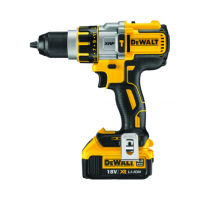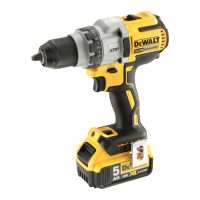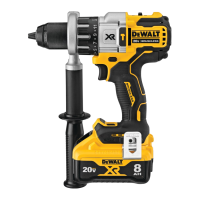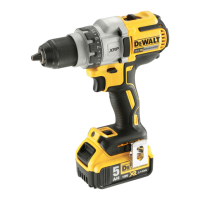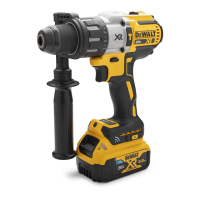13
ENGLISH
Protecting the Environment
w
Separate collection. Products and batteries marked
with this symbol must not be disposed of with
normal householdwaste.
Products and batteries contain materials that
can be recovered or recycled reducing the demand for raw
materials. Please recycle electrical products and batteries
according to local provisions. Further information is available at
www.2helpU.com.
Rechargeable Battery Pack
This long life battery pack must be recharged when it fails
to produce sufficient power on jobs which were easily done
before. At the end of its technical life, discard it with due care for
ourenvironment:
• Run the battery pack down completely, then remove it from
thetool.
• Li-Ion cells are recyclable. Take them to your dealer or a
local recycling station. The collected battery packs will be
recycled or disposed ofproperly.
Optional Accessories
WARNING: Since accessories, other than those offered
by DeWALT, have not been tested with this product, use
of such accessories with this tool could be hazardous.
To reduce the risk of injury, only DeWALT recommended
accessories should be used with thisproduct.
Consult your dealer for further information on the
appropriateaccessories.
D
Cleaning
WARNING: Blow dirt and dust out of the main housing
with dry air as often as dirt is seen collecting in and around
the air vents. Wear approved eye protection and approved
dust mask when performing thisprocedure.
WARNING: Never use solvents or other harsh chemicals
for cleaning the non‑metallic parts of the tool. These
chemicals may weaken the materials used in these parts.
C
Lubrication
Your power tool requires no additionallubrication.
MAINTENANCE
Your power tool has been designed to operate over a long
period of time with a minimum of maintenance. Continuous
satisfactory operation depends upon proper tool care and
regularcleaning.
WARNING: To reduce the risk of serious personal
injury, turn tool off and disconnect battery pack
before making any adjustments or removing/
installing attachments or accessories. An accidental
start‑up can causeinjury.
The charger and battery pack are notserviceable.
Hammerdrill Operation (Fig.A)
1. Select the desired speed/torque range using the gear shifter
to match the speed and torque to the planned operation.
Set the torque adjustment collar
5
to the hammersymbol.
2. Select the high speed 3 setting by sliding the gear shifter
8
back (away form the chuck).
3. When drilling, use just enough force on the hammer to
keep it from bouncing excessively. Prolonged and too much
force on the hammer will cause slower drilling speeds and
potentialoverheating.
4. Drill straight, keeping the bit at a right angle to the work. Do
not exert side pressure on the bit when drilling as this will
cause clogging of the bit flutes and a slower drillingspeed.
5. When drilling deep holes, if the hammer speed starts to
drop off, pull the bit partially out of the hole with the tool
still running to help clear debris from thehole.
6. For masonry, use carbide-tipped bits or masonry bits. A
smooth, even flow of dust indicates the proper drillingrate.
4. Hold tool firmly with both hands to control the twisting
action of thedrill.
5. IF DRILL STALLS, it is usually because it is being
overloaded. RELEASE TRIGGER IMMEDIATELY, remove
drill bit from work, and determine cause of stalling. DO NOT
CLICK TRIGGER OFF AND ON IN AN ATTEMPT TO START
A STALLED DRILL THIS CAN DAMAGE THEDRILL.
6. Keep the motor running when pulling the bit back out of a
drilled hole. This will help preventjamming.
Use a cloth dampened only with water and mild soap.
Never let any liquid get inside the tool; never immerse any
part of the tool into aliquid.
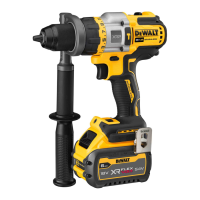
